In order to the more exact and successful performance of the duties included under the first of the above heads, the boundary line was divided by their instructions into three separate portions, one of which was assigned to each of the commissioners; and while they were instructed to assemble in a board for the purpose of comparing their respective surveys, in view of the performance of the duties included in the second of the above divisions their explorations have been separately conducted. Each of the commissioners has employed the methods and course of action most appropriate in his opinion to the successful fulfillment of his appointed task, and the nature of the surveys assigned to one of them has been of a character widely different from those of his colleagues. The commissioners, therefore, while uniting in a general report of the progress made up to this time in the duties of their appointment, beg leave to submit, in the form of appendices, the narrative of their several operations, with so much of the records of their observations and calculations as they have severally judged necessary to authenticate the conclusions at which they have arrived.
The progress which has been made in the labors of the commissioners enables them at this time to lay before you—
1. A description of the physical features of the disputed territory.
2. A comparison of the heights of the line claimed by the United States with those of the line styled the “axis of maximum elevation” by Messrs. Featherstonhaugh and Mudge. In laying the latter before you they have, in order to avoid delay, made use in part of the published results obtained by those gentlemen, and although they have already detected errors in their inferences they do not consider that by accepting them for the moment as the basis of comparison they can be accused of exhibiting the line claimed by Great Britain in an unfavorable light.
I.—DESCRIPTION OF THE DISPUTED TERRITORY.
The seacoast of the State of Maine is rugged and hilly. The primitive rocks of which its geological structure is chiefly composed are broken into ridges which run parallel to the great streams, and therefore in a direction from north to south. These ridges terminate in an irregular line, which to the east of the Penobscot may be identified nearly with the military road to Houlton. From the northern summit of these ridges an extensive view of the disputed territory can in many places be obtained. This is the case at the military post at Houlton, whence a wide extent of country may be seen. A still more perfect view may be obtained from the summit of Parks Hill, at a point about 400 yards south of the road from Houlton to Woodstock and about half a mile east of the exploring meridian line. At the time when that line was run by the British and American surveyors, under the fifth article of the treaty of Ghent, the top of this




